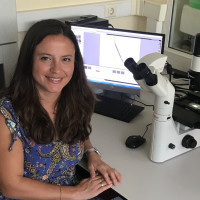Articles
Issue Reviewers
 0000-0002-2721-8822
0000-0002-2721-8822


 0000-0001-8925-1305
0000-0001-8925-1305






 0000-0002-0742-7205
0000-0002-0742-7205


 0000-0002-1816-8691
0000-0002-1816-8691
Aim & Scope
Turkish Journal of Entomology publishes original research articles in the fields of entomology and agricultural zoology in English.
Each author of the articles to be published in our journal should save their biography to https://orcid.org/signin website and upload the xxxx-xxxx-xxxx-xxxx (16 digit) ORCID ID number to the system.
The Turkish Journal of Entomology is a quarterly journal which has been published by Entomological Society. Turkish Journal of Entomology publishes original research articles in the fields of entomology and agricultural zoology in English. Authors whose native language is not English should have their paper edited professionally prior to submission. Before preparing the typescript for submission, examine the format of manuscripts already published in Turkish Journal of Entomology.
According to TJE rules, biological observations made in one location in only one-year, short notes in which the first record of a single species in Turkey is announced, and research which is older than five years will not be accepted for publication unless it forms part of a longitudinal study.
Abstracted/Indexed in Biological Abstracts, BIOSIS Previews, CAB Abstracts, FAO AGRIS, Global Health, Information Reference Library, Review of Agricultural Entomology, Science Citation Index - Expanded (SCI-E), SCOPUS/ELSEVIER, TÜBİTAK/ULAKBİM, VINITI, Zoological Record.
Each author of the articles to be published in our journal should save their biography to https://orcid.org/signin website and upload the xxxx-xxxx-xxxx-xxxx (16 digit) ORCID ID number to the system.
Author Guidelines
Turkish Journal of Entomology
Guidelines for Authors
The corresponding author should submit the manuscript to the system without author name(s)to facilitate the double-blind reviewing process. At the submission stage, author information should be entered only in the initial electronic form. After acceptance, author information should be added to the final version of the manuscript.
Is the manuscript typeset on A4 paper with top margin 3.00 cm, bottom margin 2.75 cm, left and right margins 1.75 cm, left gutter position with 0 cm gutter, header 1.75 cm, footer 1.5 cm from the sides, different first and even-odd pages? | |
Is the manuscript typeset in Arial? | |
Are the paragraph options set up as follows? Spacing: Before 0 pt, After 6 pt; Line spacing: At least at 13 pt? | |
Are page numbers aligned to the right on odd pages and to the left on even pages and written in 11 pt Arial? | |
On the first page of the manuscript, are the year, volume, issue number, page numbers, and the ISSN numbers written as header, right aligned and in 8 pt? | |
Starting with the second page, is the original title written left aligned on even pages and the author(s) information written right aligned on odd pages as header in 8 pt with underline? | |
Is “Original article (Orijinal araştırma)” written on top of the title left aligned in 12 pt bold italic? | |
Is the title of the article in English written in 14 pt (bold) and centered? | |
Is the title in Turkish written in 12 pt (not bold) centered? | |
Are the titles written with only the first word capitalized? | |
Are author names given as Name SURNAME1* Name SURNAME2 not separated with a comma, 12 pt (bold) centered and numbered as footnote (by choosing References/Insert Footnote)? | |
Are full addresses of authors, corresponding author’s e-mail and received and accepted dates written in the footnote? | |
Are all author names numbered? Is institution information given in the footnote for each number? | |
Is corresponding author indicated by placing an asterisk after the number? | |
Are Abstract and Öz titles written in 12 pt bold and centered, text body in 9 pt normal? | |
Are Abstract and Öz sections not exceeding 200 words each? | |
Are Keywords and Anahtar sözcükler entered as title 9 pt, bold, left aligned, at most five keywords, hanging 1 cm, justified? All Keywords should be placed in alphabetical order. | |
Do Abstract, Öz, Keywords and Anahtar sözcükler fit the first page? | |
Thesis, project, report information (if any available) given in the footnote in the first page written with only first word capitalized? | |
All footnotes should be 8 pt, normal, left aligned and should not end with full stop. | |
Are section titles such as Introduction, Material and Method, Research Results and Discussion written in 12 pt, bold, with 1 cm indentation in the first line, and justified? | |
Are subsection titles written in 10 pt, bold, with 1 cm indentation in the first line, and justified? | |
Is the body text written in 10 pt, normal, with 1 cm indentation in the first line, and justified? | |
Are figure captions written in 8 pt, normal, hanging 1 cm, single line spacing, and justified? (It must end with full stop) Is the text in the figures written in 8 pt normal? | |
Figures must be inserted as pictures in the Word file. If there are more than one picture/photograph/figure/graph and if these are named as a,b,c... these figures first should be inserted in a Power Point (PP) file side by side (on top of each other) and named there. Later, all of these must be selected and grouped and then must be inserted in the Word file as a picture. If the size of the picture should be adjusted, this must be done in the PP file and moved back to the Word file. | |
Is the top row of every table typeset 8 pt, normal, hanging 1 cm, with single line spacing, and justified? (No full stop at the end) Are texts within the tables written in 8 pt normal and left aligned, and the numbers normal and right aligned? Headings can be centered when necessary. Are decimal points in decimal numbers in the table aligned? | |
No vertical lines in table! | |
To avoid repetitions, is the data presented either as a table or a figure (but not both) in a way that is best understood by the reader? | |
Scientific Names |
• For up-to-date names of taxon, author, year, order and family information www.faunaeur.org must be used. |
• Scientific names should be bold and italic in section and subsection titles, and should be italic only in body text. |
• Scientific names must be written in full as Genus species, Author (Order: Family) in the main title, summary, özet, subsection titles, and where they appear for the first time in body text. |
• When scientific names are repeated in the text, genus name should be shortened; but if a paragraph or a sentence starts with a species name or in captions it should be written as Genus species (without Author, Order, Family) without shortening. |
• When giving Material examined in articles which include systematic and taxonomic research results: In alphabetical order, the city (not boldface) then, again in alphabetical order, counties, heights or coordinates, date and individual numbers with respect to the gender. |
References |
If citations are given in the text and at the end of a sentence they should be given as "(Surname, Year).", starting with the oldest reference, the ones published in the same year given in alphabetical order, each separated by a ";". If citations are given at the beginning or in the middle of the text it should be written as “Surname (Year)”. Single author: Surname, Year. Two authors: Surname & Surname, Year. More than two authors: Surname1 et al., Year. Anonymous: Anonymous, Year. Institutions (EPA, FAO, etc.): All Capital Letters, Year. |
“References” section title should be 12 pt, bold, hanging 1 cm, text should 9 pt, normal, hanging 1 cm, justified. |
“References” should be written in alphabetical order and end with “.”. |
For single author: Surname, N., Year. Two authors: Surname, N1. & N2. Surname, Year. More than two authors: Surname1, N1., N2. Surname2, N3. Surname3 & N4. Surname4, Year. |
For books: Authors, Year. Title (Each Word Is Capitalized). Publisher and City of Publication, Number of pages pp. |
For chapters in volumes: Authors, Year. “Title of the Chapter in Volume, (Each Word Is Capitalized), page range”. In: Title of the Book (Ed. Editors N. Surname). Publisher and City of Publication, Number of pages pp. |
For journal articles: Authors, Year. Title (Only the first word is capitalized). Full name of the journal (not boldface), Volume (Issue): page interval. |
Proceedings: Authors, Year. “Title (Only the first word is capitalized), page interval”. Name of the Congress/Symposium (Date, Location), Publisher (if exists), total pages pp. |
Thesis: Authors, Year. Title (Each Word Is Capitalized). Institution, (Unpublished) MSc/PhD Thesis, City, pages pp. |
Online sources: Authors, Year. Title (Only the first word is capitalized). (Web address: http://www.....), (Date accessed: Month Year). |
Online databases: Authors, Year. Title (Only the first word is capitalized). Full name of the journal (not boldface), Volume (Issue): pages. Abstracted in......, Year: Abstract No:. |
Ethical Principles and Publication Policy
The following ethical duties and responsibilities are written in the light of the guide and policies made by Committee on Publication Ethics (COPE).
• Author(s) must submit original studies to the journal. If they utilize or use other studies, they must make the in-text and end-text references accurately and completely.
• People who have not contributed to the study at the intellectual level should not be indicated as author.
• If the manuscripts submitted to be published are subject of conflicting interests or relations, these must be explained.
• During the review process of their manuscripts, author(s) may be asked to supply raw data. In such a case, author(s) should be ready to submit such data and information to the editorial and scientific boards.
• Author(s) should document that they have the participants' consent and the necessary permissions related with the sharing and research/analysis of the data that are used.
• Author(s) bears the responsibility to inform the editor of the journal or publisher if they happen to notice a mistake in their study which is in early release or publication process and to cooperate with the editors during the correction or withdrawal process.
• Authors cannot submit their studies to multiple journals simultaneously. Each submission can be made only after the previous one is completed. A study published in another journal cannot be submitted to Turkish Journal of Entomology. Author responsibilities given in a study (e.g.: adding an author, reordering of author names) whose review process has begun cannot be changed.
General duties and responsibilities
Editors are responsible for each study published in Turkish Journal of Entomology. In this respect, the editors have the following roles and responsibilities:
• Making efforts to meet the demand for knowledge from readers and authors,
• Ensuring the continuous development of the journal,
• Managing the procedures aimed to improve the quality of the studies published in the journal,
• Supporting freedom of expression,
• Ensuring academic integrity,
• Following the procedures without making concessions on intellectual property rights and ethical standards,
• Being transparent and clear in issues that require correction or explanation.
Relationships with Readers
Editors must make decisions taking into consideration the knowledge, skills and expectations of all readers, researchers and practitioners need. They must also ensure that the published studies contribute to literature and be original. Moreover, they must take notice of the feedback received from researchers and practitioners and provide explanatory and informative feedback.
Relationships with Authors
Editors have the following duties and responsibilities in their relations with authors:
• Editors must make positive or negative decisions about the studies' importance, originality, validity, clarity in wording and suitability with the journal's aims and objectives.
• Editors must accept the studies that are within the scope of publication into pre-review process unless there are serious problems with the study.
• Editors must not ignore positive suggestions made by reviewers unless there are serious problems with the study.
• New editors, unless there are serious issues, must not change the previous editor's decisions about the studies.
• "Blind Review and Review Process" must be published and editors must prevent possible diversions in the defined processes.
• Authors should be provided with explanatory and informative feedback.
Relationships with Reviewers
Editors have the following duties and responsibilities in their relations with reviewers:
Editors must
• Choose reviewers according to the subject of the study.
• Provide the information and guidance reviewers may need during the review process.
• Observe whether there are conflicting interests between reviewers and authors.
• Keep the identities of reviewers confidential in blind review.
• Encourage the reviewers to review the manuscript in an unbiased, scientific and objective tone.
• Develop practices and policies that increase the performance of reviewers.
• Take necessary steps to update the reviewer pool dynamically.
• Prevent unkind and unscientific reviews.
• Make effort to ensure the reviewer pool has a wide range.
Relationships with the Editorial Board
Editors must make sure that the members of the editorial board follow the procedures in accordance with the publication policies and guidelines, and must inform the members about the publication policies and developments. Moreover, editors must
• Ensure that the members of the editorial board review the manuscripts in an unbiased and independent manner.
• Select the new members of the editorial board from those who can contribute to the journal and are qualified enough.
• Send manuscripts for review based on the subject of expertise of the editorial board members.
• Regularly communicate with the editorial board. Arrange regular meetings with the editorial board for the development of publication policies and the journal.
Relationships with the Journal's Owner and Publisher
The relationship between the editors and publisher is based on the principle of the independency of editors. All the decisions made by the editors are independent of the publisher and the owner of the journal as required by the agreement made between editors and publisher.
Editorial and Blind Review Processes
Editors are obliged to comply with the policies of "Blind Review and Review Process" stated in the journal's publication policies. Therefore, the editors ensure that each manuscript is reviewed in an unbiased, fair and timely manner.
Quality Assurance
Editors must make sure that articles in the journal are published in accordance with the publication policies of the journal and international standards.
Protection of Personal Information
Editors are supposed to protect the personal information related with the subjects or visuals in the studies being reviewed, and to reject the study if there is no documentation of the subjects' consent. Furthermore, editors are supposed to protect the personal information of the authors, reviewers and readers.
Encouraging Ethical Rules and Protection of Human and Animal Rights
Editors are supposed to protect human and animal rights in the studies being reviewed and must reject the experimental studies which do not have ethical and related committee’s approval about the population given in such studies.
Precautions against possible Abuse and Malpractice
Editors are supposed to take precautions against possible abuse and malpractice. They must conduct investigations meticulously and objectively in determining and evaluating complaints about such situations. They must also share the results of the investigation.
Ensuring Academic Integrity
Editors must make sure that the mistakes, inconsistencies or misdirections in studies are corrected quickly.
Protection of Intellectual Property Rights
Editors are responsible for protecting the intellectual property rights of all the articles published in the journal and the rights of the journal and author(s) in cases where these rights are violated. Also, editors must take the necessary precautions in order to prevent the content of all published articles from violating the intellectual property rights of other publications.
Constructiveness and Openness to Discussion
Editors must
• Pay attention to the convincing criticism about studies published in the journal and must have a constructive attitude towards such criticism.
• Grant the right of reply to the author(s) of the criticized study.
• Not ignore or exclude the study that include negative results.
Complaints
Editors must examine the complaints from authors, reviewers or readers and respond to them in an explanatory and enlightening manner.
Political and Economic Apprehensions
Neither the owner of the journal, publisher or any other political or economic factor can influence the independent decision taking of the editors.
Conflicting Interests
Editors, acknowledging that there may be conflicting interests between reviewers and other editors, guarantee that the publication process of the manuscripts will be completed in an independent and unbiased manner
Ethical Responsibilities of Reviewers
The fact that all manuscripts are reviewed through "Blind Review" has a direct influence on the publication quality. This process ensures confidentiality by objective and independent review. The review process at Turkish Journal of Entomology is carried out on the principle of double-blind review. Reviewers do not contact the authors directly, and the reviews and comments are conveyed through the journal management system. In this process, the reviewer views on the evaluation forms and full texts are assigned to the author(s) by the editor. Therefore, the reviewers doing review work for Turkish Journal of Entomology are supposed to bear the following ethical responsibilities:
Reviewers must
• Agree to review only in their subject of expertise.
• Review in an unbiased and confidential manner.
• Inform the editor of the journal if they think that they encounter conflict of interests and decline to review the manuscript during the review process.
• Dispose the manuscripts they have reviewed in accordance with the principle of confidentiality after the review process. Reviewers can use the final versions of the manuscripts they have reviewed only after publication.
• Review the manuscript objectively and only in terms of its content and ensure that nationality, gender, religious and political beliefs, and economic apprehension do not influence the review.
• Review the manuscript in a constructive and kind tone, avoid making personal comments including hostility, slander and insult.
• Review the manuscript they have agreed to review on time and in accordance with the ethical rules stated above.
Ethical Responsibilities of Publisher
The Editors and the Editorial Board of Turkish Journal of Entomology are conscious of the fact that they must observe the ethical responsibilities below and act accordingly:
• Editors are responsible for all the processes that the manuscripts submitted to Turkish Journal of Entomology will go through. Within this framework, ignoring the economic or political interests, the decision-makers are the editors.
• The publisher undertakes to have an independent editorial decision made.
• The publisher protects the intellectual property rights of all the articles published in Turkish Journal of Entomology and holds the responsibility to keep a record of each unpublished article.
• The publisher bears all the responsibility to take the precautions against scientific abuse, fraud and plagiarism.
Unethical Behavior
Should you encounter any unethical act or content in Turkish Journal of Entomology apart from the ethical responsibilities listed above, please notify the journal by e-mail at galip.kaskavalci@ege.edu.tr (Editör in Chief Prof. Dr. Galip KAŞKAVALCI).
Price Policy
There is € 135 / USDollar 150 charge “Submission Fee” for manuscript submissions to TJE.
When a manuscript accepted for publication, an article cannot be published unless the "Copyright Form" is signed by all authors and sent to the Journal.
No "Royalties" are paid to the authors for their article.
Authors are fully responsible for the contents of their article, and publication in the Journal does not represent any form of endorsement by the Society.
There is € 135 / USDollar 150 charge “Submission Fee” for manuscript submissions to TJE.
The receipt of submission fee must be uploaded in pdf format by clicking the "Upload Supplementary File" button in the "Submission" files stages.
For payments in ₺ from within Turkey:
Please deposit to the Entomological Society of Turkey and Turkish Journal of Entomology Bank Account.
Akbank, Özkanlar Branch (746) Account No: 2590
IBAN: TR55 0004 6007 4688 8000 0025 90
For international payments in USDollar or €:
Please use the Western Union Money Transfer System.
Send money on behalf of “Firdevs Ersin”, and give details and MTCN number to the Treasurer of Entomological Society of Turkey (firdevs.ersin@ege.edu.tr).

